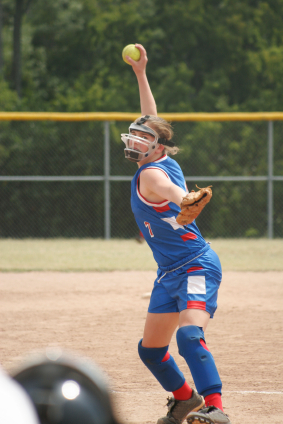Over the past decade, a lot of attention has been directed towards stemming the tide of arm injuries in baseball. While pitching injuries among youth baseball players have been extensively studied, not much has been written about preventing injuries among pitchers in softball.
In its recent Baseball and Softball Policy Statement, the American Academy of Pediatrics noted that many injuries to softball pitchers are located, not where the problem originates, but at a more remote location on the body, the weakest link in what is called the "kinetic chain."
For example, noted the AAP, although 70% of injuries to collegiate softball pitchers were from overuse, only 13% were reported in the lower extremity, and the majority were shoulder or elbow injuries, even though weak gluteal muscles and lack of pelvic stabilization were the "culprit."
The report thus recommends, first, that examination and treatment of shoulder pain in windmill softball pitchers include an assessment of and rehabilitation for pelvic stability and gluteal strength, and evaluation and treatment of scapular stabilization, as well as the affected shoulder or elbow, and second, that off-season and pre-season conditioning programs for softball windmill pitchers include gluteal strengthening and pelvic stabilization exercises.
What is the kinetic chain?
The kinetic chain in throwing a baseball or softball is the combination of movements, starting at the feet and working up to the hand, which results in the release of the ball towards its intended target. Ball speed and direction are the result of each body part adding to the next.
Whether you are a parent or coach, you don't have to be an expert in biomechanics in order to break down this process in order to improve your athlete's performance and reduce the risk of injury. What is important is that your child perform the appropriate training exercises that support a strong body, addressing both improving performance and reducing risk of shoulder injury.
Conditioning exercises
1. Single Leg Squats
This exercise maximizes not only leg strength but improves balance, particularly important with the landing leg during pitching. Have your athlete stand on single leg and slowly squat as low as possible while maintaining the following:
- Level shoulders
- Level hips
- Hands close into body (boxing position
- Knee facing straight forward (not rotated inward)
- Pressure even through middle of foot
Maintaining this position is important because if the body shifts in either direction, it will not translate as well to throwing. The landing leg in softball acts as a shock absorber, but also as a firm platform from which to begin rotating the body to release the ball. Weakness in the landing leg results in increased risk of straining the shoulder from compensating for a body leaning too far right or left.
2. Lunge with Upper Body Rotation
Have your athlete complete a walking lunge with a weighted ball (anywhere from 5-10 pounds is fine if shoulder strength is sufficient). With each lunging step, the arms should be out straight and rotating from side to side while maintaining the chest forward and level balance through the hips and shoulder. This exercise helps improve core control when fully outstretched on a single leg, very similar to the softball pitching motion.
3. Shoulder Flexion Laying Flat on Stomach
Have your athlete lay on a workout bench with each arm draped to the side. With a light weight (2-3 pounds maximum) have the athlete, with the elbows straight, lift straight in front of the body until the weights are level with her head. This exercise may be difficulty initially, so starting off without weights is perfectly appropriate if necessary to maintain proper form. This exercise is important because it increases scapular strength, particularly the lower trapezius, a muscle that helps tilt the shoulder backward to reduce risk of shoulder impingement.
Maintaining form
With all exercises, form is the most important aspect. Since pitching is a combination of muscle endurance and a controlled outburst or release of muscular power, performing a high number of repetitions and sets during pre-season is important. 2 to 3 sets of 15 to 20 reps of each exercise will improve overall body balance. B
Make sure your young pitcher completes all exercises on each side, not just the throwing arm or landing leg. Balance is critical to accurate and hard throwing, as well as reducing overuse injuries from a body breaking down from fatigue and weakness.
1. American Academy of Pediatrics Council on Sports Medicine and Fitness, Baseball and Softball Policy Statement. Pediatrics 2012;128(3):842-856 (doi 10.1542/peds 2011-3593)(www.pediatrics.org/cgi/doi/10.1542/peds2011-3593 (accessed February 27, 2012).
Posted March 13, 2012









